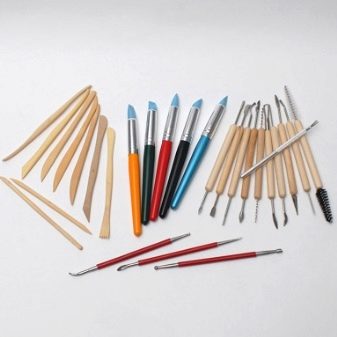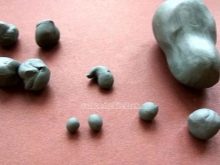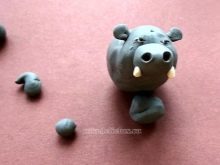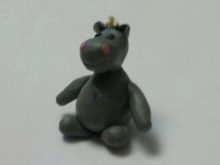How to mold a hippo from plasticine?

Modeling is so varied that you can almost endlessly master new versions of it. Along with the usual animals of domestic latitudes and fairytale heroes, sometimes you can create a hippopotamus from plasticine. That is why it is important to figure out how to blind a hippo step by step for children, and what it takes to make it.



Tools and materials
They tend to make crafts of bright colors in the first place - this is quite natural for both children and even adults. But the hippopotamus can be dazzled even if only plasticine of discreet shades remains. For work, only gray, white and black tones are needed, while very few white and black pieces are needed. You will also need:
- matches;
- toothpicks or meat skewers;
- stacks;
- special modeling blades.


Simple option
It is quite possible to get a plasticine hippopotamus figure even for younger preschool children. To clearly recreate the image of an African animal, one must focus on its display in cartoons and fairy tales. One way or another, it is necessary to demonstrate:
- large head;
- almost complete absence of a neck;
- short powerful legs;
- durable thick leather;
- strength and sluggishness.


They begin to sculpt the exotic beast in stages, kneading the plasticine. It is necessary to focus on this point for the reason that the process will be long. For young children, it is recommended to purchase soft grades of material. They allow you to do without much effort, but keep their shape well. Then:
- sculpt a large gray pear, a wide section of which will become a belly, and a narrow one - a head;
- prepare small soft pieces of plasticine for all other parts of the body;
- form legs and tail;
- take care of the ears;
- stretch the muzzle forward.
Then you will have to turn a narrow section of the gray pear towards you. A small ball is glued to the face, which must be pressed down with the pad of your finger. The eyes of the animal are created from black grains. The ears are made small so that they are slightly visible. With the help of a match, you need to push through the nostrils, and to the left and right of the slightly open mouth, glue white fangs. But a real hippo must have legs. They resemble cropped gray cylinders. Match halves will provide a secure fit.
The ponytail is made from a small gray ball. As you can easily see, such a scheme is really quite simple.



There is also an alternative option. Its characteristic feature is adding pink nostrils. But it will not reach them right away, and the bulk will again be gray. The sequence of steps is as follows:
- body sculpting (it is very important to demonstrate both the fatness of the hippopotamus and its straight, relatively flat back);
- sculpting the head (it must be immediately put in the designated place);
- the formation of paws (the lower ones are thick and relatively short, but the upper ones are made thinner and slightly pulled in length);
- fastening these paws in the right places;
- the formation of small black eyes;
- preparation of ears (they have characteristic gray "cakes" of an initially undefined shape);
- production of nostrils;
- drawing a smile with a toothpick or a stack;
- preparation of blond hair with a pretty "hairstyle".



How to make a pink hippo?
It is also not difficult to mold an attractive, funny-looking pink figure from plasticine step by step. For work, you will need plasticine not only pink, but also red, white, black, yellow. But the gray mass is not needed at all. There is also no big need for a stack - it can be easily replaced with a toothpick. The first step in sculpting is shaping the head. A couple of plasticine pieces of different sizes go to it.
Red plasticine is thoroughly kneaded. A smaller piece is rolled into an oval, a larger one - into a circle.
Important: the round workpiece should be slightly flattened. Then the parts are glued to each other. The oval is placed vertically and the circle is placed horizontally.


Next steps:
- molding of the same circles from yellow plasticine;
- flattening them thoroughly;
- folding the part and sticking it on the head;
- gluing with a wide face down, while controlling the location of all parts in one plane;
- preparing a couple of small flat circles;
- attaching these eyes to their proper place;
- preparation and installation of black pupils (their position determines the expression of the hippopotamus's eyes);
- sticking pink eyelids;
- work with paws;
- covering the body with pink mass;
- flattening of the marigold;
- drawing a nose and a smile.



For information on how to mold a hippo from plasticine, see the next video.








